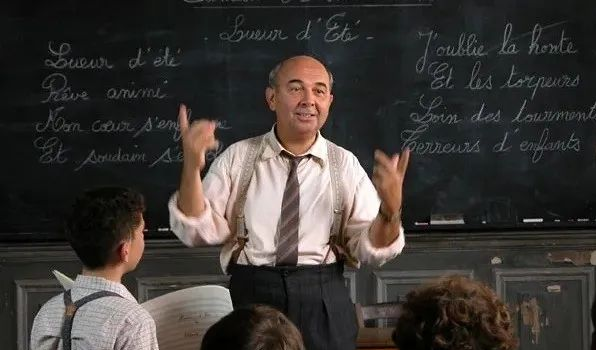Les choristes: The Beauty of Music and the Love of Humanity

Les choriste is a film based on music, directed by Christophe Barratti, which was released in theaters in 2004 and won the French box office that year for its simple, heartfelt story and the profound musical art it contains. In the three years since its release, it has won numerous cultural awards. In particular, the original music presented in the film won not only the Best Composition Award at the European Film Festival (2004), but also the 30th French César Award for Best Soundtrack and Best Sound Effects. Les choriste is a French film, which is not based on the exaggerated drama of great sorrow and great joy, but on the simple and simple narration of the whole story, using mildly colored images to show the delicate love of the main character, Mr. Matthieu, and to tell the story of the growth and transformation of the small character in “The Bottom of the Pond”. “The whole story is a simple, uncomplicated narrative. Love” is a simple theme in movies, but it is difficult to show it through the camera. “Les choriste” uses the main tone of musical chorus and the audio-visual language to show it in front of the screen, which not only makes the viewer feel love and hope, but also gives people deeper thoughts.

01.The cleverness of the narrative structure
The film adopts the flashback performance in space, which makes the time travel, and also reflects the unique charm of film art. The opening sequence of “Les choriste” is similar to the opening sequence of “Nuovo cinema Paradiso”. The same two artists who have achieved fame and fortune, the same two expatriates who have left their homeland, the same exhausted bodies and minds, the same return to their hometown for a funeral, and even the same nostalgic and melancholic mood, intuitively judging that the main characters’ experience must be extraordinary, they return to France with Pierre in a curious mood, which brings the audience a suspenseful and interesting beginning. It is the basic to make the audience want to watch the film. The film is told through a diary, so that the first protagonist of the film is positioned in the body of the owner of the diary – an assistant teacher Matthew, with the first-person “I” narration, through the camera time and space back to January 1949, the camera pushed to the The story officially begins with the prologue, which takes only 4 minutes and 30 seconds to lay out the story and open the door. The story is composed of two clues: one is the growth experience of Pierre Moanche. How he metamorphosed from a troubled teenager to a world-renowned conductor, his emotional, formative experiences are the main story line. The other thread is the experience of assistant teacher Matthew at the boarding school, from the time he enters the school to the time he leaves it to teach the children with music. These two threads are intertwined, intertwined and independent. It is because each of the two threads of the story unfolds at the beginning and is placed in an equally important position that makes the story rich and three-dimensional and makes the two main characters complete and independent. If the experience of the two main characters is the film’s bright line, then the story of Principal Hasson can be considered a dark line, because he also comes from a musical background and used to be a flautist, a contrast to Matthew’s dedication to music, his way of educating students, and his realization of self-worth, etc. He is a symbol of the authoritarian system in the film, as if the air pervades around the school, and his “Every practice and success of Matthew is a rebellion against Hassan’s authoritarian violence and against the “action-reaction” system he set up. The “behavior-reaction” system he set up. Matthew’s trail with the addition of Hassan only more ups and downs, conflicts highlight the wonderful. For example, in the film, after Matthew found the children’s interest in music, he actively composed the music and quietly rehearsed at night, reporting to his superior Hassan, who was cold about it and threw cold water on Matthew, who agreed on the surface and actually waited for Matthew to make a fool of himself to see his joke, which also aroused Matthew’s fighting spirit and promoted the development of the storyline. The success of Matthew’s teaching practice again proves the pale powerlessness of the authoritarian system. At the end, the film returns to the image of a graying Pierre with a journal in his hand, who completes the story with Pierre, whom Matthew has taken away. In his student Pierre, Matthew’s dream of music, Matthew’s desire for beauty and even Matthew’s dead life are naturally continued and realized. The last two clues of the film have a beginning and an end, a clear explanation, parallel and complete. The last shot ends the film with the car driving, with the beautiful singing of the choir, which is warm and touching. Throughout the film, the narrative features create a compact structure, outstanding plot, and a wonderfully complete story.

02. The application of warm and cold tones
Tone is the total color organization and configuration of the color film picture, which is often dominated by one color and makes the picture present a certain color tendency. In the narrative of the whole film, the director takes the dominant color, and the film is shown in a way that the color tones are first cold and then warm, and through the color changes, the development of the storyline and the emotional changes of the characters in the story are accentuated. From the beginning of the story narrated by the main character Matthew until Pierre joins the choir is gray-blue tones, rendering a dreary and depressing atmosphere, Matthew himself flirted with the idea that he was a musician caught in the “bottom of the pond”, and when he came to the boarding school, he was already basically desperate for the musical dreams he had, a gray state of mind with gray tones. The students are in an oppressive and authoritarian environment, lacking warmth and love, as if they are in a horrible hell, with no hope for their future or dreams, and spend their days playing pranks and rebellious behavior to relieve their boredom. Of course, this is also the time of winter, the weather is gloomy and cold, but the director’s use of tone not only takes into account the natural environment, but mainly echoes the storyline. When Pierre officially joins the choir, the sun appears and the hue suddenly turns orange, which is obviously a deliberate move by the director to foreshadow a shift in the direction of light, where music can make the day sunny. From Matthew’s diary for March, the spring season, the choir also ushered in their own spring and sunshine, blue-gray hue also reflects his “problem teenager” psychology. But Pierre is lucky to meet Matthew, who shines a bright light into his heart and soul, using music as a cure for the disheveled and helpless “thousand horses”, allowing him to grow up like a genius and shine brightly. Matthew planned a blueprint for Pierre’s future, and Pierre proved to be successful, so the use of warm tones also confirmed Pierre’s future – the brightness after joining the choir, where the application of tones is mainly to express the theme, rendering the atmosphere, in response to the time, but also reflects a stylized creation.

In addition, the director’s choice of costumes for the characters is also quite thoughtful. The characters in the film wear clothes in brown, white, gray and other dark tones, and the children do not have bright clothes and shoes, showing the tedium and dullness of their daily lives, often sanctioned by violence, which is incompatible with the colorful life of children, and the teachers are dressed formally, with white shirts and formal coats, showing the teachers’ ideas Stereotypical, backward educational concept.
03. The use of props
In the classroom at the bottom of the pond, Mr. Matthew sees a skeleton with a cigarette, which shows the children’s rebellion against the teacher, rebellion, hostility, and teasing, which means that Mr. Matthew faces the children’s rebellion and hostility has just begun. The iron fence and iron gate appear several times in the film, and also in Wang Jiawei’s film “The Flowering Years”. These images indicate a certain kind of confinement, and the iron fence and iron gate that appear several times in the film “Springtime in the Cattle Class” also imply that the children are confined by the education at the bottom of the pond. The diary appears at the beginning of the film, and appears four times in the film. It not only serves to narrate the story in the form of flashbacks, but also brings Molonger and Pepino together at the beginning of the film, so that the story can proceed smoothly. In the diary, Mr. Mathew records a summary of the children’s slow change. In the 18th, 25th, 48th, 53rd and 74th minutes of the film, the lamp appears several times. The orange light shows Mr. Matthew in a backlit silhouette, in reality he is a short figure, but in the backlit silhouette, it shows his huge body. The lamp is also a metaphor for the fact that Mr. Matthew is like a hard-working gardener.
In the 57th minute of the film, paper airplanes appear. Paper airplanes are a kind of intention in the film, it is a kind of trust, when the children fly up the paper airplanes in the spring, even the principal is “touched”, standing on the stool and folding up the paper airplanes and shooting them out. In the 87th minute of the film, Mr. Matthew left the school, at the turn, the warm sunlight and paper airplanes through the warm color show, in the tall and serious school building, the window is so high and so small, but can not stop the children will fold the plane from the window, that is a metaphor for the hopes and ideals of the children’s hearts, through the paper airplanes to convey everyone’s wishes, the tender little hands from the window, and the small, tender little hands from the window. In contrast to the tall and grim school building, the director thus pushes the film to its climax.
